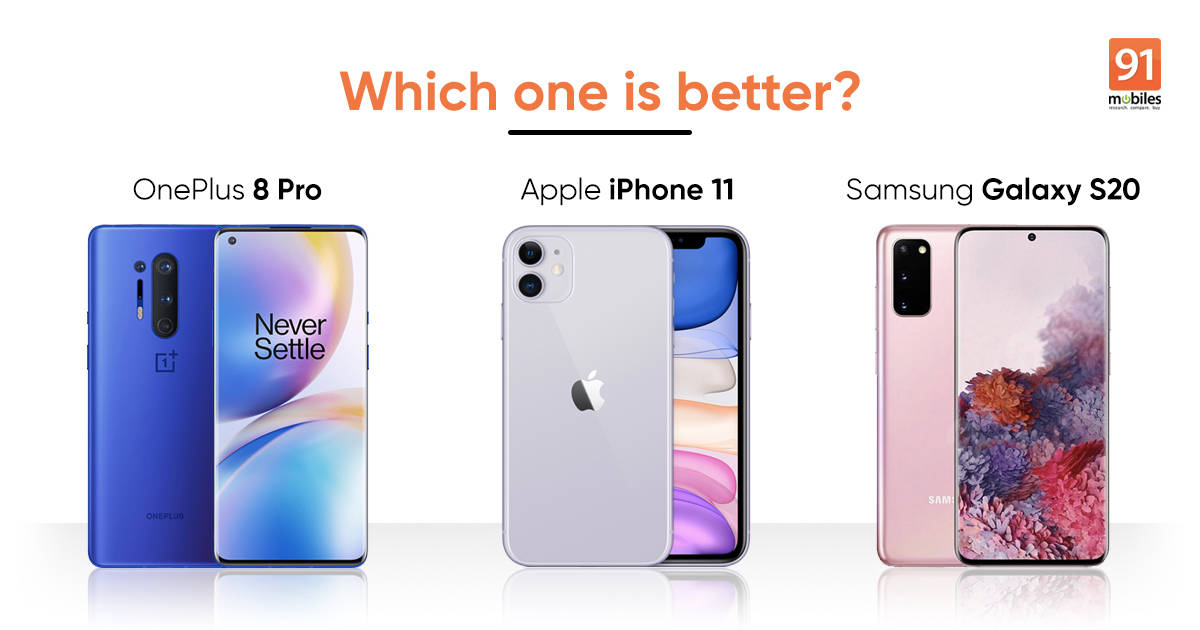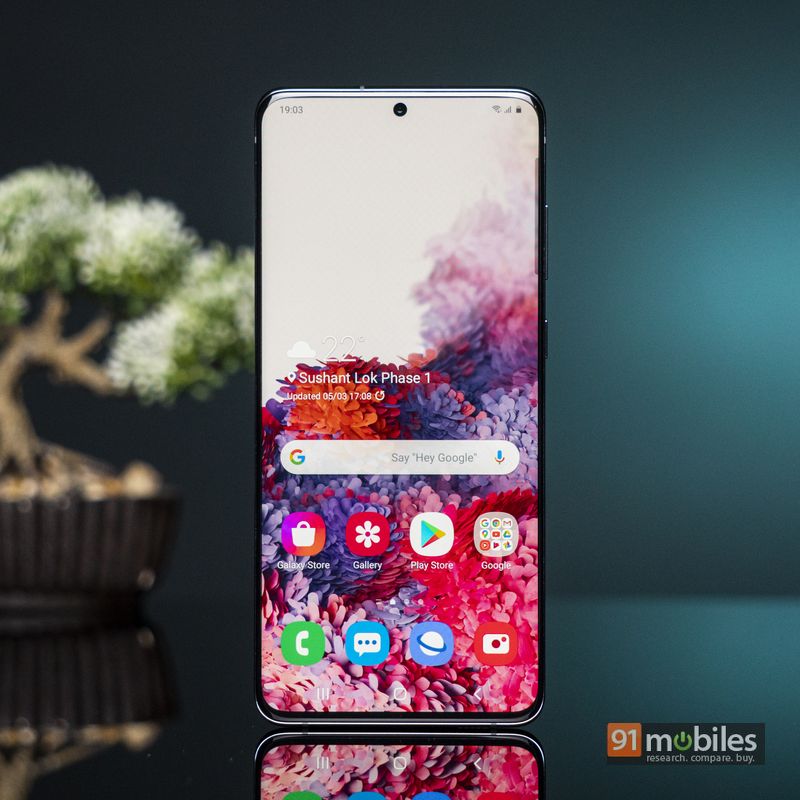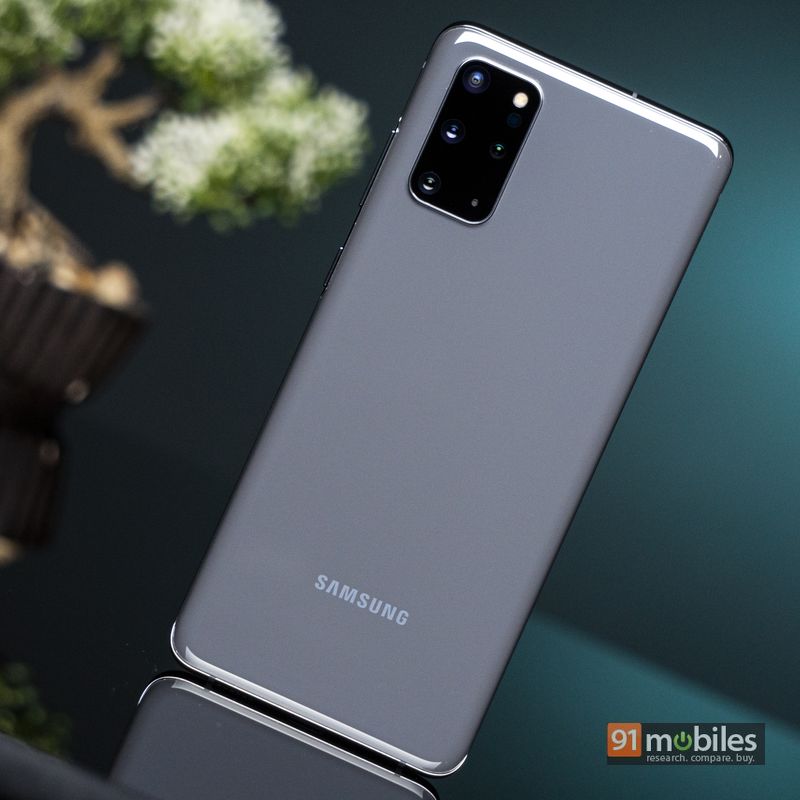
The recently launched OnePlus 8 Pro comes with all the bells and whistles one would have expected. The handset touts flagship chipset, 120Hz refresh rate, quad rear cameras, IP68 rating, and fast wireless charging support that is rated to charge the device in no time. That doesn’t mean the OnePlus 8 Pro comes cheap. The handset is the most expensive OnePlus offering to date. The OnePlus 8 Pro price in India puts it in the same ballpark as the iPhone 11 and Samsung Galaxy S20. We’ve compared the specifications and prices of the three phones to evaluate the best possible option.
Table of Contents
Design and display
The OnePlus 8 Pro flaunts a 6.78-inch Fluid AMOLED display that bears 120Hz refresh rate, QHD+ resolution, HDR10+, and 19.8:9 aspect ratio. The screen even features a punch-hole at the top-left corner for the selfie camera and slightly curved edges. The rear panel of the phone flaunts a glass layer and vertically-aligned cameras at the centre. The phone has a volume rocker and power button along with alert slider placed on the left edge and right edge respectively.

The Samsung Galaxy S20, on the other hand, features a 6.2-inch Dynamic AMOLED Infinity-O display with QHD+ resolution, HDR10+ support, and 20:9 aspect ratio. The cut-out for the selfie camera is centre-aligned atop the display. The rear panel of the phone, which has a glass-layer by the way, houses nothing but a rectangular-module for triple cameras. There is no Bixby button this time, and the volume buttons and power rocker are placed on the right spine of the phone.

As for the iPhone 11, it flaunts a 6.1-inch Liquid Retina HD+ display with a wide notch atop, 19:9 aspect ratio, and standard 60Hz refresh rate. The handset features dual rear cameras and a glass sandwich design. The power button is on the right spine, whereas the volume rocker and alert slider are on the right edge of the phone. Unlike Samsung Galaxy S20 and OnePlus 8 Pro – which has USB Type-C port – the iPhone 11 rocks Lightning port for charging. The only commonality between these phones is that none of them rocks a dedicated 3.5mm headphone jack.
Performance and software
The OnePlus 8 Pro is powered by the mighty 7nm octa-core Qualcomm Snapdragon 865 SoC. This is paired with Adreno 650 GPU, 5G modem, 8GB/ 12GB fast LPDDR5 RAM, and 128GB/ 256GB UFS 3.1 storage. You cannot expand the storage on the OnePlus device. Software-wise, the handset boots Android 10-based OxygenOS out of the box.

The Samsung Galaxy S20 ships in India with the company’s in-house Exynos 990 chipset with 4G LTE modem, which is considered equivalent to the Snapdragon 865 SoC. The phonemaker ships the Samsung Galaxy S20 with 8GB of RAM and 128GB storage onboard, which can be further expandable up to 1TB using a micro SD card slot. The handset comes pre-loaded with Samsung’s One UI 2 atop Android 10 out of the box.

Apple’s iPhone 11, meanwhile, runs iOS 13 out of the box and packs A13 Bionic chipset under the hood. It’s the most powerful chipset in the industry at the moment. The SoC comes with up to 256GB storage onboard, which is non-expandable.
Cameras
In the imaging department, the OnePlus 8 Pro sports quad rear camera setup with 48MP Sony IMX689 (f/1.78) primary sensor with OIS and EIS. This is paired with an 8MP (f/2.44) telephoto lens with OIS and 3X hybrid zoom, a 48MP (f/2.2) ultra-wide sensor with 119.7-degree field-of-view, and finally, a 5MP (f/2.4) colour filter sensor. The front camera of the phone gets a 16MP Sony IMX471 sensor with EIS and f/2.45 for selfies and video calling. The cameras are backed by a slew features, including HDR modes, Nightscape, Super macro, Portrait Pro mode, AI scene detection, and up to 4K video recording support.

Samsung Galaxy S20 features triple rear cameras, consisting of a 12MP wide-angle sensor with an f/1.8 aperture, Super Speed Dual Pixel AF, and OIS; a 12MP ultra-wide angle lens with an f/2.2 aperture; and a 64MP telephoto camera with an f/2.0 aperture, PDAF and OIS. Some of the new camera features include a 3x hybrid optical zoom, Super-Resolution Zoom up to 30x, and a new shooting mode called ‘Single Take,’ which captures a short video, along with a photo from all the sensors, for various perspectives. The selfie camera consists of a 10MP sensor with an f/2.2 aperture.

The iPhone 11 doesn’t have as many cameras and the fancy resolution, but it’s among the best camera phones out there in the market. The handset packs dual 12MP cameras with a wide-angle main shooter with f/1.8 lens and optical image stabilisation (OIS) and a 12MP secondary ultra-wide-angle shooter with f/2.4 aperture and 120-degree field of view. The cameras are backed by next-generation Smart HDR, Night Mode, Portrait Mode, 4K video recording support at 60fps. The front camera on the iPhone 11 sports a 12MP shooter that is capable of shooting video in 4K as well as slo-mo videos. The phones lacks a dedicated telephoto lens, which means its zoomed shot may not be as good as Samsung Galaxy S20 or OnePlus 8 Pro.
Battery, security, and connectivity options
The OnePlus 8 Pro is driven by a 4,510mAh battery with Warp Charge 30T wired and Warp Charge 30 wireless charging support that is rated to charge device up to 50 percent in 30 minutes. As for Samsung Galaxy S20, it houses a 4,000mAh battery with only 25W Quick Charge and 15W wireless charging tech. Both handsets also come with reverse wireless charging support. For security, the OnePlus 8 Pro touts in-display fingerprint scanner, while the Samsung Galaxy S20 has an ultrasonic in-display fingerprint scanner.
The iPhone 11, meanwhile, packs a 3,110mAh battery with 18W fast charging support (though only 5W charger is shipped with the box) and 7.5W wireless charging support. The phone relies on Face ID for security.
Prices in India
The OnePlus 8 Pro price in India is set at Rs 54,999 for the 8GB RAM + 128GB storage variant, while the top-end 12GB RAM + 256GB storage variant costs Rs 59,999. The phone comes in Glacial Green, Onyx Black, and Ultramarine Blue colours and will be available for sale in the country in May 2020 via Amazon.in, OnePlus official website, and offline retail stores.
Samsung Galaxy S20 was initially launched at Rs 66,999 but is now priced at Rs 70,500 thanks to the revised GST rates. The handset is available in Cloud Pink, Cloud Blue, and Cosmic Gray hues.
The iPhone 11 price in India has also been increased after the new GST rate on mobile phones. The handset is now available for sale starting at Rs 68,300 instead of Rs 64,900 in the country for the 64GB storage variant. The phone’s 128GB and 256GB variants will set you back to Rs 73,600 and Rs 84,100. The iPhone 11 comes in as many as five colour options: black, green, purple, white, and yellow.

















